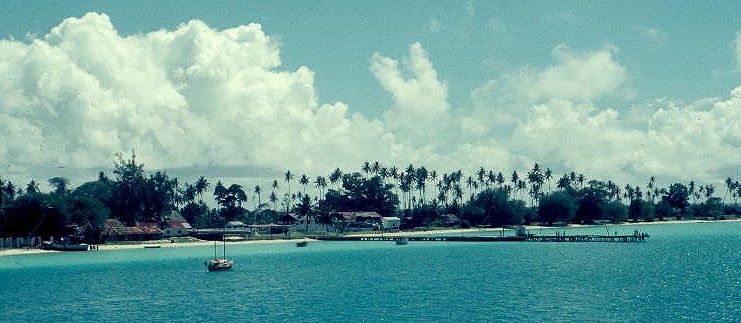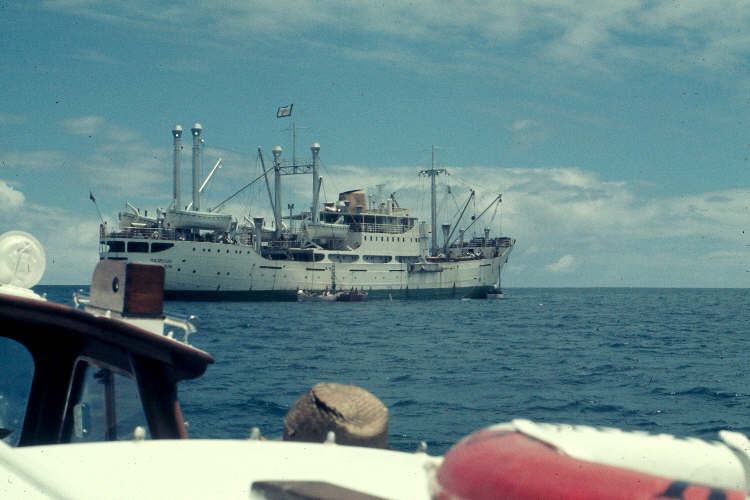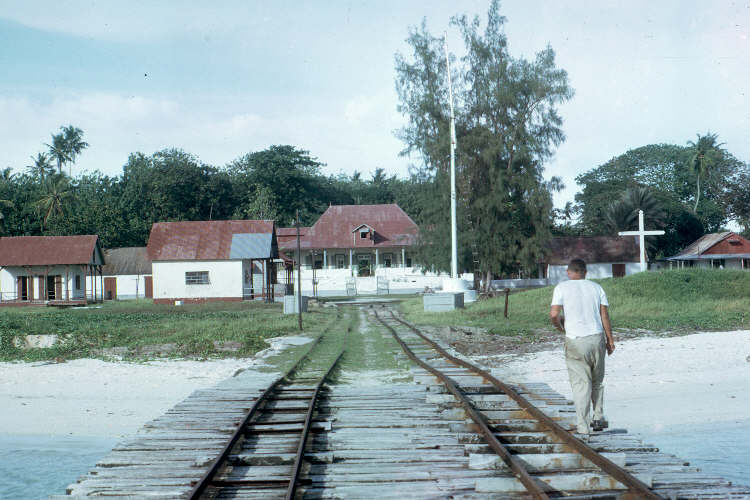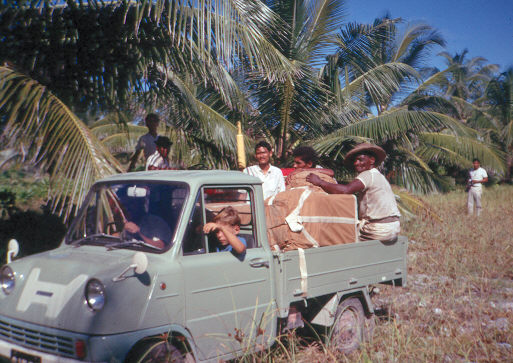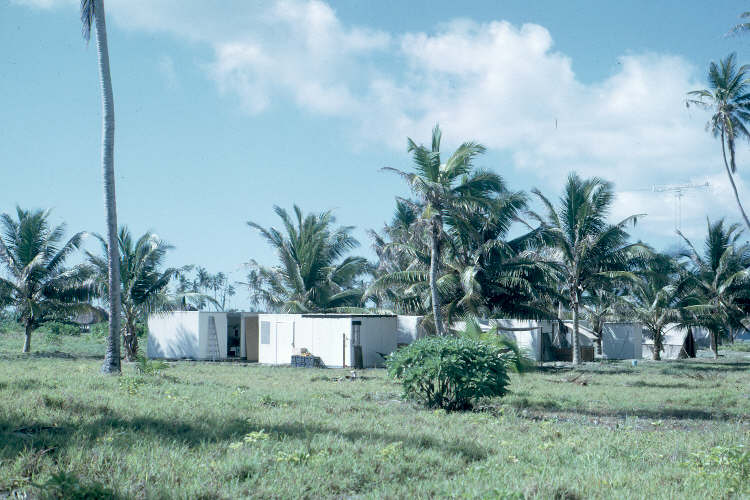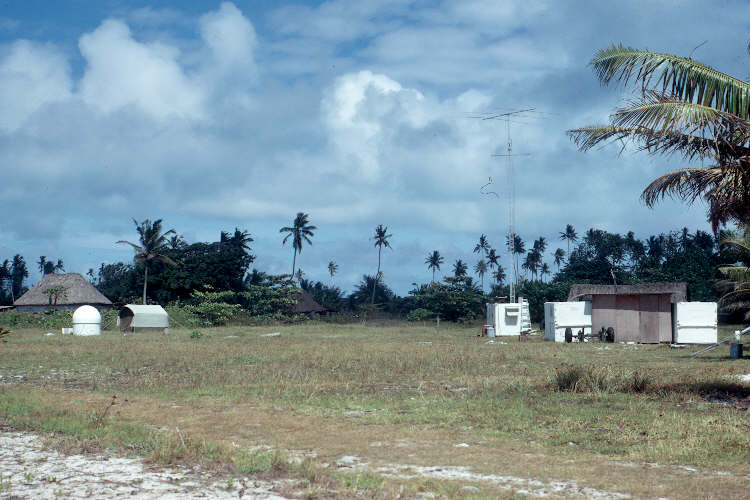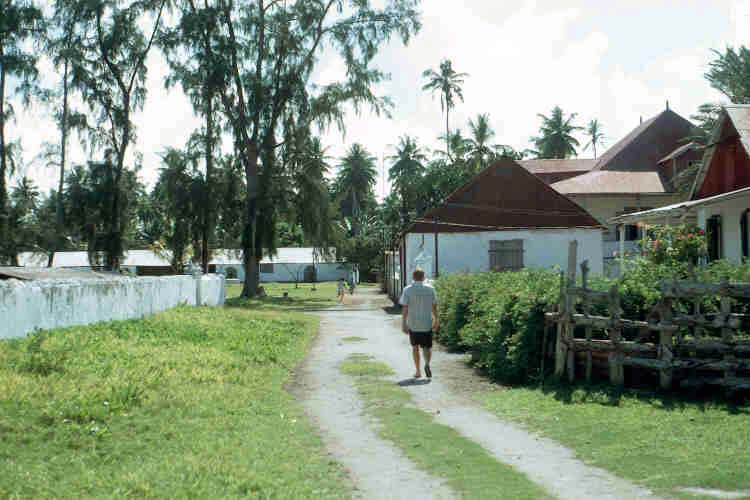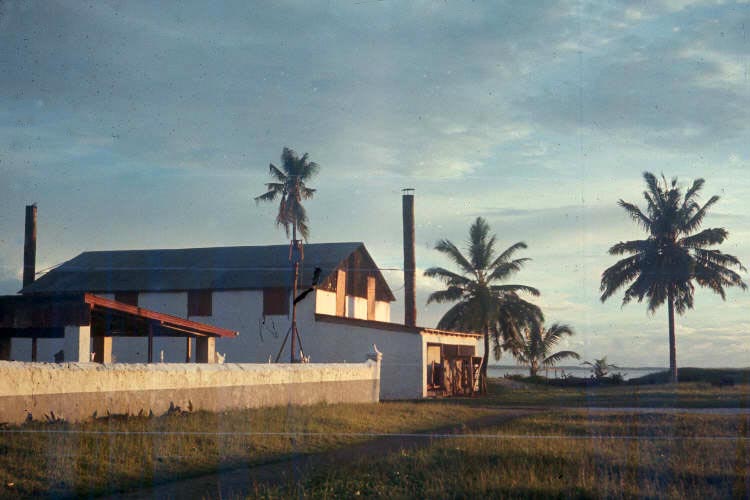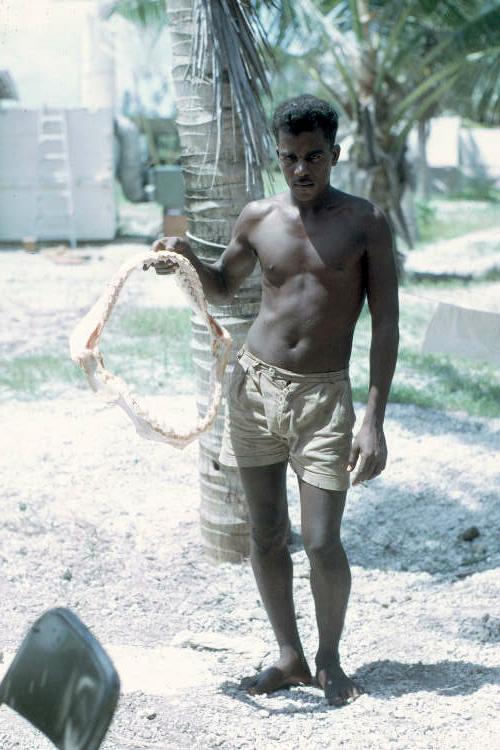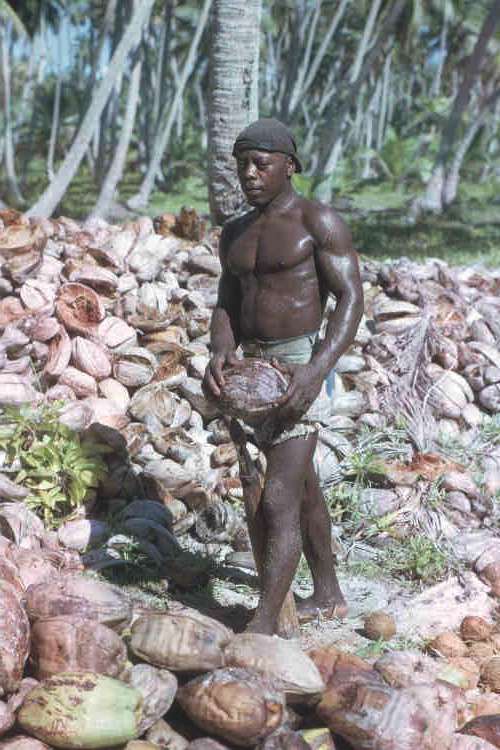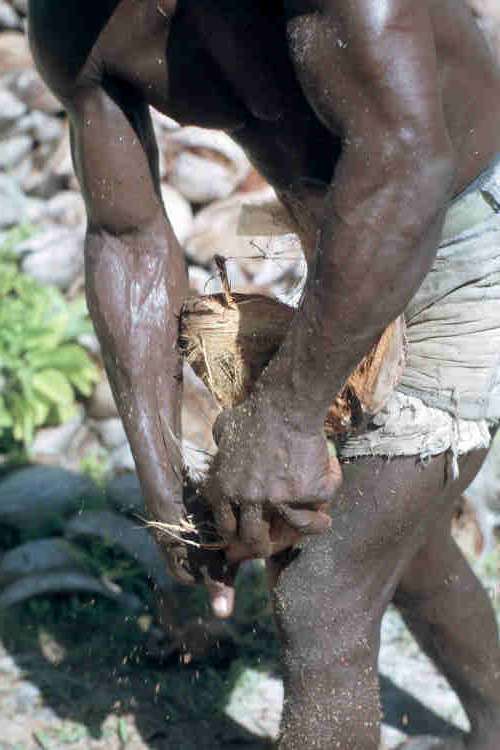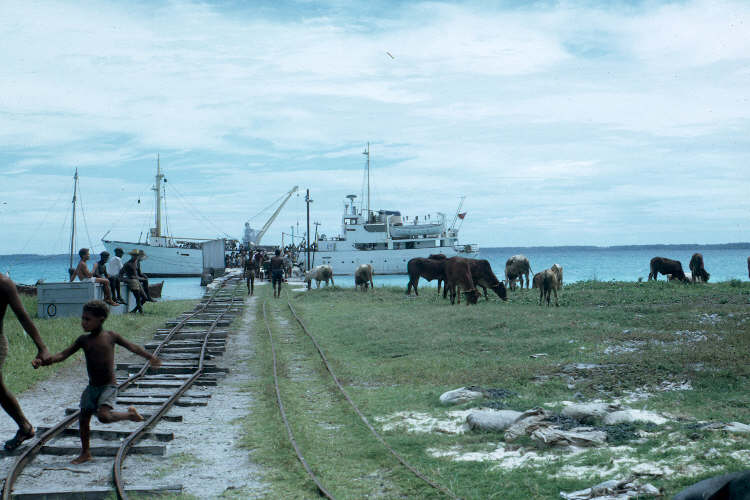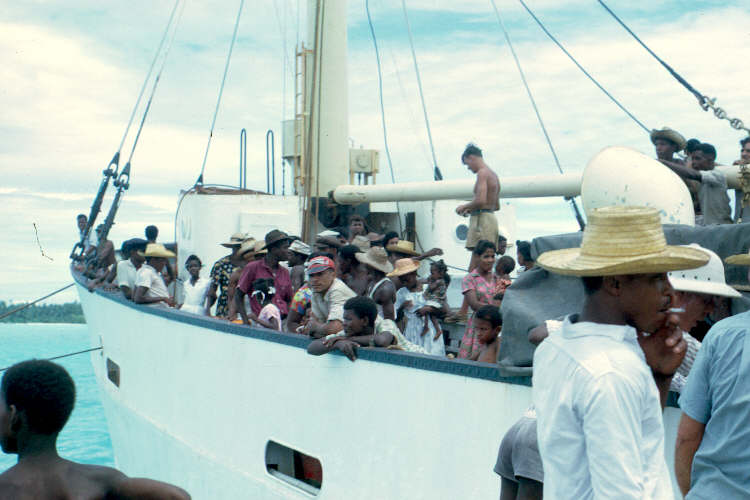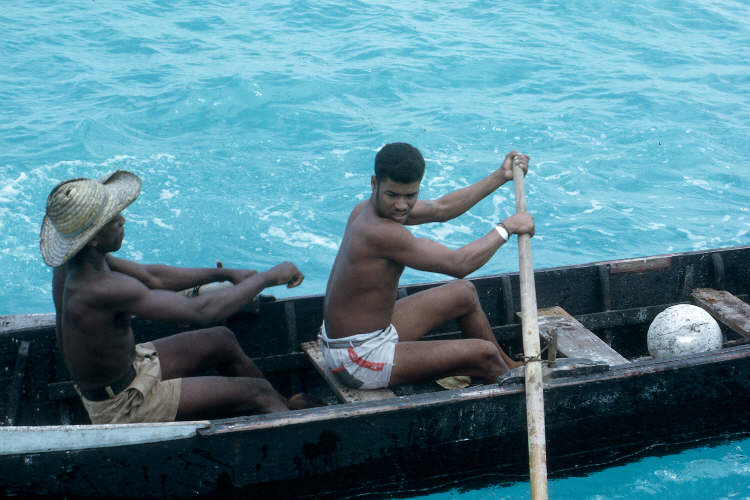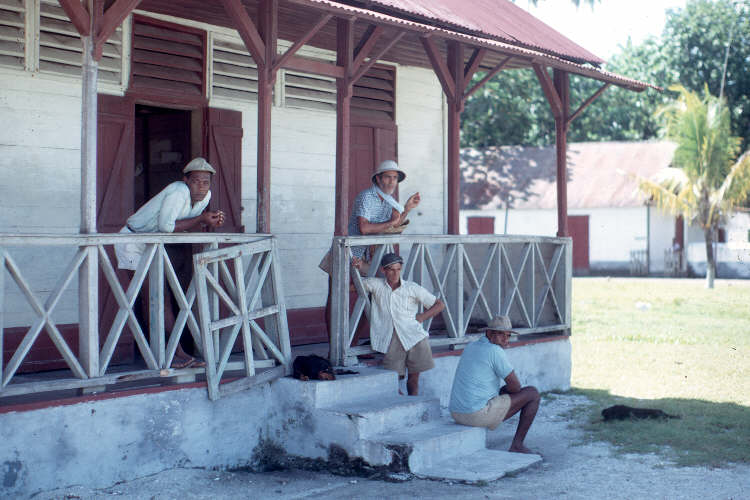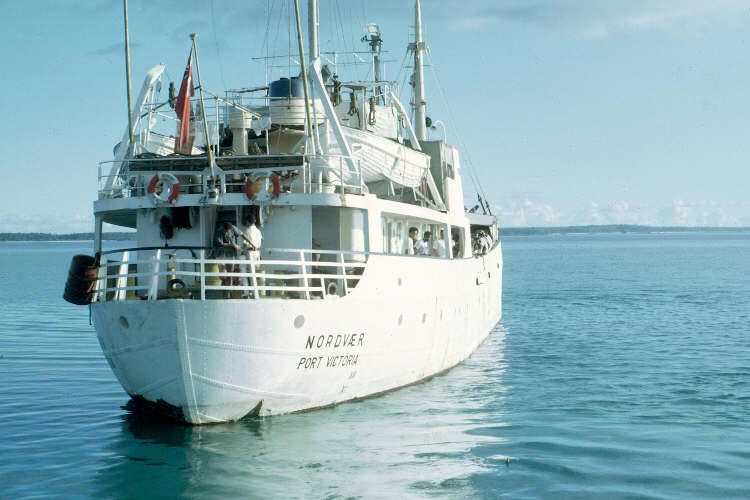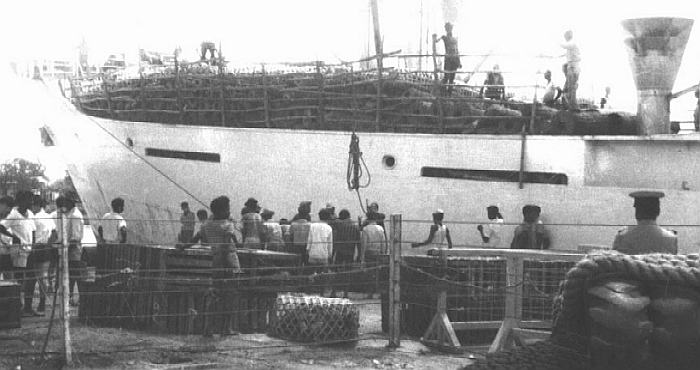|
Kirby Crawford, Gus Jones, Fred Milwee,
Paul Jacobs, Dick Kyle, Mike Ellett,
The Plantation as seen from the M/V
Mauritius, November 16, 1968  From Kirby Crawford: 1968-69 Initially there were five of us Americans and five Filipino national contract people. We worked for the US Army Topographic Command, (formerly Army Map Service, later Defense Mapping Agency). In November, 1968 Gus Jones and I packed up our tracking station in Quito, Ecuador and accompanied the equipment through the Canal Zone, Charleston AFB, Catania Sicily, Addis Ababa and finally arriving in Mauritius on a USAF C-141. While in Charleston, Fred Milwee, Paul Jacobs and Dick Kyle (cook), joined the team as well as five Filipino contract technicians. Others who rotated in later were; Mike Ellett, Alex Pinter, John Webb, John Shaffery and Roger Zejdlik. We spent 12 days in Mauritius buying
food and supplies and assembling the 90 tons of
equipment shipped in earlier from
Washington. Information about landing
facilities on DG was limited so the 10 of us
built a 12 x 24 foot landing barge out of angle
iron, 55 gallon drums and plywood for decking.
We built the barge on the docks in Port Louis in
one day.
The occupation of Diego Garcia by a US
Department of Defense tracking team was
considered very sensitive and therefore was kept
very quiet. Our occupation was approved by
the British government and the BIOT. We were
surprised to find that a Soviet vessel followed
us most of the way to DG. It kept its distance
just off the horizon. Russian vessels were also
seen from the island occasionally during our
occupation.
Early on the the morning of the 16 of November we spotted the long thin green line on the horizon. At that point we were wondering what lay in store for us and what it would be like to live on this remote island for a year or two. At 10:00 AM we arrived just off the jetty at East Point. After some delay we started offloading our equipment with the help of the plantation manager and his workers. Our equipment included portable buildings for living quarters and kitchen, 60kw diesel generators with 6 months supply of diesel fuel in 55 gallon drums, tons of electronic and surveying equipment, a Dodge Power wagon and approximately 6 months supply of food and frozen meat that we bought in Mauritius. The first exciting thing to happen was
while offloading the Power Wagon from the ship
onto the home made barge. The truck was
lowered over the side in cable nets around each
wheel. The front wheels contacted the
barge first and they rolled out of the nets and
all but the last foot of the back end of the
truck was under water! Luckily, one cable
had snagged around the axle. We took the truck
apart that night to flush all the salt water out
but it was never quite the same even though we
kept it running for nearly two years. It became
the cancer wagon.
Without the help of the plantation
workers, we would never have accomplished
offloading some 90 tons of equipment by
ourselves. The Plantation Manager, Regenald
Payett, invited us to stay in the rear quarters
of the plantation house. It was like stepping
back a hundred years in time. The
plantation operated without electricity. They
had one small Honda truck, "the bloddy honda",
and a tractor. Other than that, most
everything was done by hand. Copra
production was in full swing and plantation
workers lived all over the island.
After looking around the island, I selected a site for our camp and station just 1/4 mile east of the plantation on the ocean. The plantation helped clear the brush and we started assembling our building in a nice grove of young coconut palms. We got our generators running right away to keep our several hundred pounds of meat frozen. After about 3 weeks we had assembled our buildings, got the kitchen working and moved into camp.
During that same time we assembled
our satellite stations. The four of us
Americans set up a "BC-4 Satellite
Triangulation Station". This was a large
stellar camera mounted on a concrete pier and
covered by a fiberglass dome. We
photographed large balloon satellites at night
along with the star background. This was
part of the International Satellite
Triangulation Program, a joint venture of USA
Topocom and the US Coast and Geodetic
Survey. When two or three of these
stations, located approximately 1000 miles
apart, photographed the same satellite at
exactly the same time, along with star
backgrounds, the precise ground positions in
latitude and longitude could be computed. This
was the first program to accurately measure
the size and shape of the earth and measure
the precise relationships between the major
mapping datums of the earth. We also conducted
a precise astronomic position survey using a
conventional highly accurate astronomic survey
instrument, (Wild T-4). Incidentally our
surveys determined that Diego Garcia had been
plotted approximately 2 miles in error on the
current charts of that time.
The five Filipino technicians operated a SECOR radar tracking station to support the same program. They competed their work after 4 months and left on the first ship to come in from the Seychelles.
Henry Moreno, one of the Filipinos fancied himself as a western cowboy among other things. There were a half dozen "wild" horses that roamed the island and they used to come galloping through our camp about 5:00 AM every morning. The story was that some of them were ex race horses from Mauritius. One day Henry, with the help of Fred Milwee, caught the largest horse. Henry used to try to ride it but only got bucked off repeatedly so they let it go, (I have slides of this).
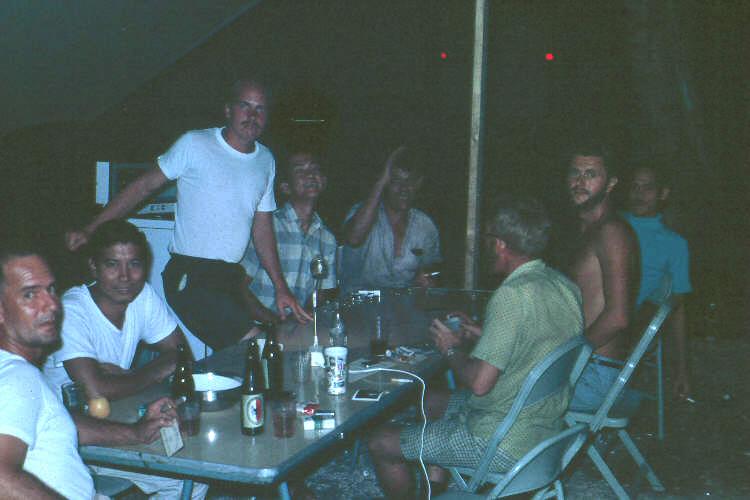 Typical Saturday night poker game in front of the kitchen in our camp. Left to right: Regenald Payett-plantation manager, Filipino, Paul Jacobs, Filipino, Franz Brassel-plantation mechanic, Fred Milwee (with beard), Henry Moreno the Filipino Cowboy, and Gus Jones. During the first week or so, Regenald decided to show us some Diego Garcia entertainment. He brought us over to the shore by our site with the "bloddy honda" loaded with three or four large green turtles (a no no), He and Franz Brassel threw the turtles on the sand and proceeded to chop them up with an ax and throw them into the shallow surf. Within 15 minutes the water was red and teaming with a number of good sized white tipped sharks. Now that's entertainment! Franz Brassel, the island mechanic showed us another amazing thing. Over in the plantation, he wrapped wire around the tail of a large coconut crab and hung it from a rafters in his shop. He said "now watch this". He lifted a 25 lb. steel bar up and the crab immediately grabbed it with one of his large claws. Franz said "now you come back tomorrow and see". So in the morning we went over and sure enough, the crab was still holding that steel bar!
I had a .22 automatic pistol so we used to walk out on the coral shelf at camp and shoot at sharks as they swam through the incoming waves. Gus Jones and I had bought a bunch of salt water fishing gear in Panama so we used to walk out on the coral shelf and cast bait out over the edge with 30 lb. line. We would hook into monster fish but were never able to bring one up because the line would break on the coral. The best fishing was with the plantation folks in the large dugout canoes in the lagoon. One day the island fisherman came into camp with a large set of fresh shark jaws that he could lower down over his body. He told the story of how he had hooked it with a hand line in his dugout canoe at the mouth of the lagoon. It pulled him far out to sea before he could get it along side and harpoon it.
One of the island workers known to us as "Samson" was built like Arnold Swartzenegger (sp). Each worker had a weekly quota of coconuts to gather and husk. Sampson could do his quota in three days and take the rest of the week off. It was amazing to see him work, . After a few years on the island, Sampson was offered his free trip back to the Seychelles. He stayed in the Seychelles for one ship and returned to Diego and said he would be happy to spend the rest of his life on Diego. One of the Filipino workers was found to have taken liberties with the wife of the manager at Pointe Marianne. Regenald sentenced him to 7 days in the steel doored prison at the main plantation. He was given bread and water. That seemed to take care of the problem.
Our cook Dick Kyle had trouble adjusting to the island life so he left on the second ship. So for the remaining time I was there, we did all of our own cooking. We all took our hand at it. Most notorious was Alex Pinter's hungarian dishes with super hot peppers.
Another social activity was the "sega" parties. This was a brew made of fermented coconut juice by the workers. These parties were supposedly outlawed by the BIOT but they popped up here and there on Saturday nights. One Saturday night we were invited to one of these and it was wild. The music consisted of four 55 gallon drums beat on with rocks and fantastic singing by a women with the loudest voice. The songs were stories in the Seychellious (sp) language about daily life, folk lore and many other things, (I have tape recordings of this). To hear those recordings, go to http://www.zianet.com/tedmorris/dg/1969sega.html
It came to be that Regenald's daughter had a need to marry one of the young plantation gentlemen. So we pitched in and helped marry off his daughter in style. We supplied electricity to the plantation house, booze, music food and a big wedding cake. A good time was had by all.
We always wanted to go fishing out in the ocean so after we got a new shipment of generators, Alex Pinter took on the project of building a motor launch, A old wooden boat about 30 feet long, originally used to haul coconuts, was acquired from the plantation. Alex and Franz installed one of the old generator motors, fabricated a prop shaft out of an old iron bar in the blacksmith shop, and installed a brass propeller that was found at the plantation. That rig and its crew were almost lost out to sea one time when the engine quit during a storm, (slides available). A favorite Saturday night activity was to pack up the Power Wagon with food and beer and head up to Northeast Point for some night shark fishing from shore. Alex was notorious for pulling big sharks ashore and filling them full of holes with his Walther PPK. When the moon and the tides were right, one could walk out on the coral shelf and find hundreds of large spiny lobsters. The procedure was to carry a flaming torch and a gunny sack. Just walk around on the coral in about a foot of water and pick them up. Our team kept a large supply in the freezers for trading material whenever ships called at the island. We ate lobster until it came out our ears. We had gallon cans of butter to go with them. Sometimes when the ship didn't come in, the island would be out of tobacco among other things. It was not uncommon for a plantation worker to spend the day walking all the way from Pointe Marianne around to our camp with a dozen eggs to trade for a couple of cigarettes!
SPECIAL NOTE: From
George Wuethrich, June, 2001: This photo is
especially interesting because the gentleman seated
on the stairs is Michel VINCATASSIN, the grand
father of two real Diego Garcian friends, Spencer
David VINCATASSIN (svincata@yahoo.com) and Andre
Allen VINCATASSIN (aav@chagos.org). Spencer and
Allen are cousins. Allen was one of the last babies
to be born in Diego in 1970. There were two meager
compensations offered to the Chagossians, Michel
VINCATASSIN was the one who started the second one.
He fled Diego along with baby Allen in 1971, since
Allen's parents were sent in an other boat (family
ties were not respected). Before leaving, Michel was
the only Chagossian who had the idea to establish a
paper stating that he was Diego Garcian and
establishing the fact that his family and himself
had always worked and lived in Diego. Arriving in
the Seychelles, he showed the paper and did so again
in Mauritius were Gaetan DUVAL, the head of the
Creole party, invited him to sue the UK. So he did
in 1975. He sued the UK for illegally exiling him,
and his paper was the proof. Even the US Congress
spoke of it in 1975. But Michel was old and could no
longer go to London. So other family members
went. Finally Great Britain said it would give
a compensation if Michel withdrew his case from the
High Court. A rumor also served this purpose. It was
said to the Chagossians that the case was a personal
one, and that the 4 million £ would go to the
VINCATASSIN, not to all Chagossians. A riot followed
in which Michel and Allen nearly died, the
Chagossians wanting to burn down their house. The
Mauritian police had to protect the house, and Allen
remember coming back from school under police
protection, and since the Mauritian police was
Our only communication was a ship every 3 or 4 months and a high frequency radio that allowed us to talk to Washington on a daily basis when the conditions were right. There was another BC-4 team about 1000 miles south of us on Heard Island, one of the most remote locations on earth with some of the worst weather. They went in by ice breaker and stayed there for one year without any ship visits. Their HF radio had problems so the only connection to the outside world was by radio voice with us on Diego. So they would write their letter home to loved ones and read them to me over the radio. I would record them on a tape recorder, type them up and mail them off on the next ship. Months later when their letters would come in I would read them over the radio to them. One day after I had been on the island for a year, I was working on the generators with Alex. We were expecting a British ship to come in and pick me up in about a week. A runner came into camp from the plantation and said that a British motor launch was at the jetty looking for Mr. Crawford. I had 10 minutes to pack my bags, say good-bye and make it over to the jetty. Before I knew it I was on board ship sailing off to Mauritius, then a flight to Nairobi and another to Brussels to meet my girlfriend for a month vacation touring Europe. Talk about a culture shock! It was a wonderful and adventurous time living on Diego Garcia even though it was isolated. We listened to the moon landing on short wave radio from the BBC. It was ironic to be so isolated in the middle of the Indian Ocean and hear the live words "Houston, the Eagle has landed"! Those of us who were on Diego Garcia remain close friends and occasionally have a Diego Garcia reunion to tell war stores, show slides and relive those days on DG. This is only a small sampling of the many stories that we share about our times there when the island was as it had been for hundreds of years. Little were we to know that it was to become a large military installation in the near future. It was our "Gilligans Island"! Most of this is from memory so it's as
accurate as my memory serves.
Kirby Crawford
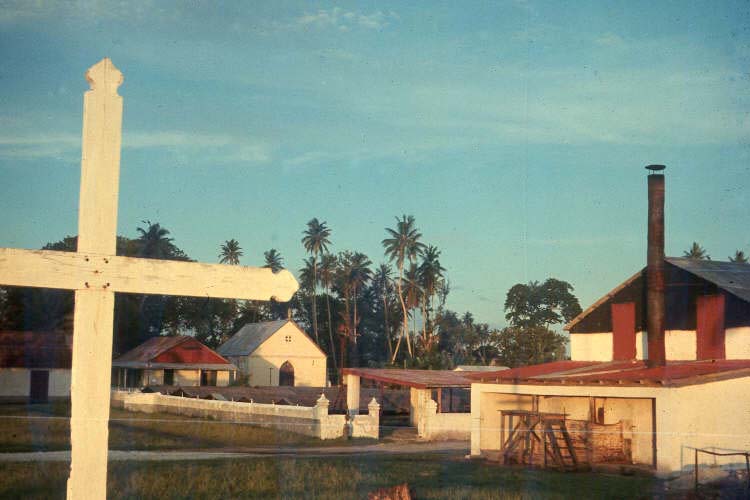 Evening at the Plantation - 1968
Addendum: April, 2001. Ted: "Kirby - I noticed there are cows in one of the photos of the NORDVAER. Were there cows permanently on the island, or were they just passing through and let off to graze?" Kirby: "On the cows, I think the plantation maintained a few cows but I'm not 100% sure. I know they raised pigs. The plantation give us fresh pork on those rare occasions when they butchered. The pork had a distinct sweet coconut flavor because they fed them copra." Ted: "I wonder why they took the pigs off with them when they left, but not the donkeys, and especially the horses? You'd think those animals would have some value elsewhere. But maybe not in the bigger geopolitical picture! Also, do you remember anything about orchards, gardens, fruit trees, etc.? Any thing at all about the staples of the local diet, where they got them, etc.? In the pamphlet there's several mentions of bringing in ship loads of topsoil for crops, and on several places on the island I recall a thin topsoil from decomposed leaves, fronds, etc. But I don't remember any producing fruit trees at all, even over around the plantation." Kirby: "It's possible that they ate all the pigs during the last year when the powers that be started to cut back on shipping in food and supplies etc. Or, possibly the Ilois felt that the pigs were valuable enough and also transportable enough to take with them when they left.
"The plantation had a very
productive garden or gardens in the vicinity of the
managers house, back in the bush where the ground was
protected from the salt air. One of my team members,
Gus Jones, tried to cultivate a garden just west of
our camp with seeds that we brought in with us. The
plants would sprout up an inch or so and then the salt
air would kill them. Gus still works for the
government out of St. Louis and is currently on a
mapping trip in Argentina. I'll pick his mind when he
gets back about what types of vegetables & fruits
etc. the plantation was growing. Gus has a great
memory when it comes to details such as that.
Here are some
pictures of the schooner ISLE OF FARQUHAR.
Courtesy of Roger Zejdlik. He spent two weeks aboard sailing (literally) from Mauritius to Diego Garcia in 1968. This ship played an important role in the history of Diego Garcia. On October 15, 1971, it carried the last of the Plantation workers off the island and into exile. 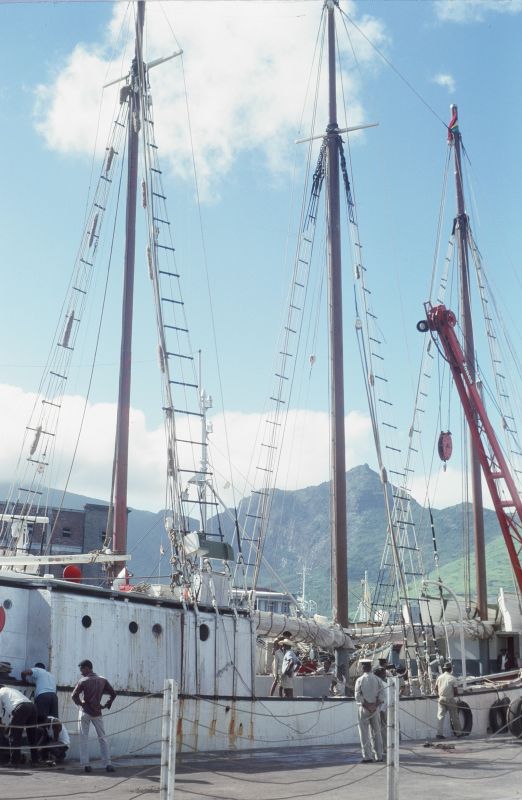 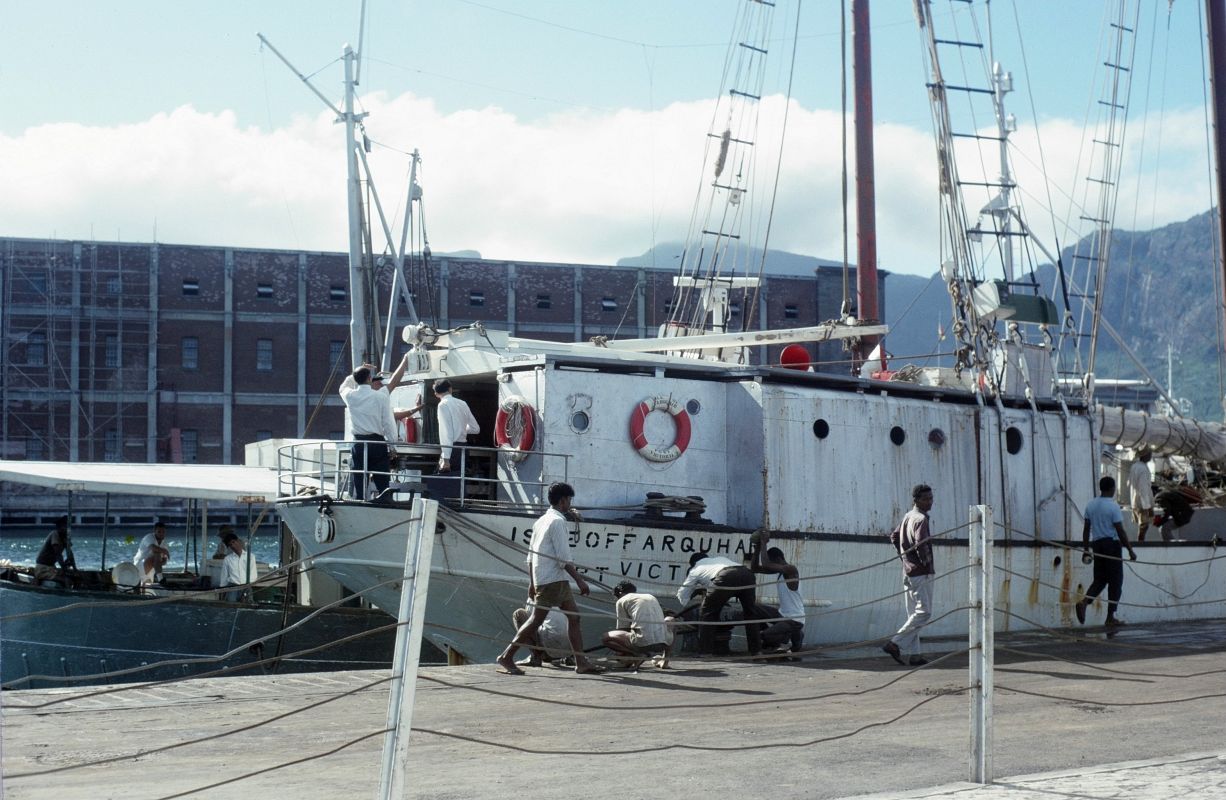
Subject:
The
Very First Americans On Diago Garcia Island
65
Seventh Avenue Tel: + 27
31 765 5140
|
